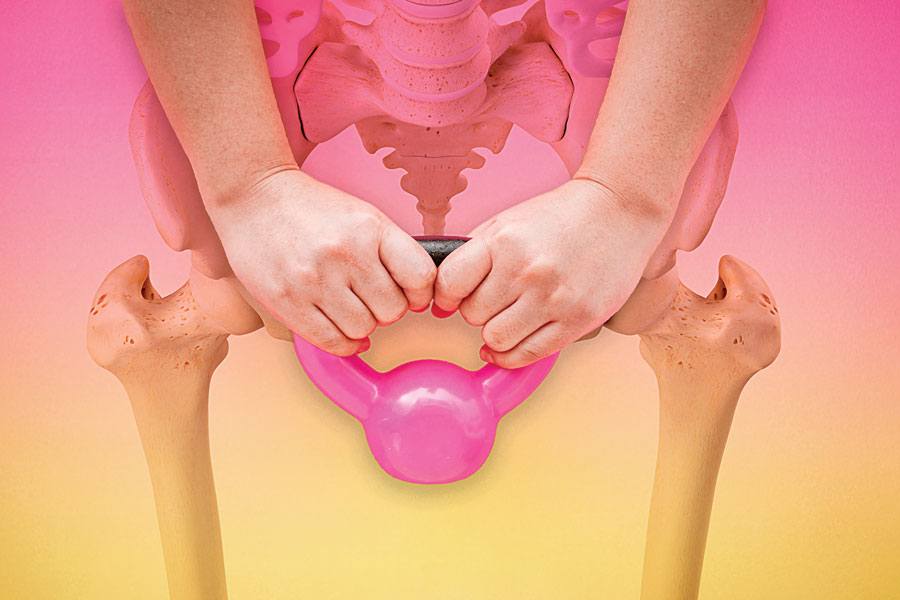The Body Part You’re Probably (But Definitely Shouldn’t Be) Overlooking
Your pelvic floor plays a key role in so many activities: exercising, having sex, delivering a baby, breathing. Why are so few people talking about it?

Photo-illustration by Jamie Leary
When local pelvic-floor yoga therapist Debbie Brownstein first became aware of her own pelvic floor, she was 30 years old.
One year after having her first child, she was grooving to the live sounds of the Disco Biscuits with friends. One of them had brought a mini trampoline to the concert (*makes mental note to go to a concert with Brownstein and her friends*), but when it was Brownstein’s turn to jump, something unexpected happened. “Three jumps in, I peed myself. I was shocked — this had never happened to me before,” she says.
Brownstein called her midwife, who told her that urinary incontinence — the inability to control bladder function — “just happens after you have a child” and to “do some Kegels,” because her pelvic floor was likely weakened from pregnancy and delivery.
“I was so frustrated,” Brownstein says. “I kept wondering why nobody up to this point of my life had told me what a pelvic floor is or what can happen to the muscles due to trauma. For the next five years, I worked with a specialist not only to rehabilitate my pelvic floor, but to process all the emotions that arose over not knowing something so basic about my own anatomy.”
That was 2005. Nearly two decades later, public conversations and awareness about pelvic health — while improved — are still minimal. As a result, folks either don’t pay their pelvic floors any mind (how can you support something you’re completely unaware of?) or suffer in silence because they believe their dysfunction is “normal.” The problems extend beyond those who’ve given birth: The first time I came across the term “pelvic floor” was in 2017, when Girls star Zosia Mamet announced she finally had an answer for her frequent bathroom-going and pain with sex after years of misdiagnoses and dismissals. She, like me, hadn’t even heard of a pelvic floor before. Unfortunately, Mamet, like many others, didn’t find out what it was until dysfunction set in.
And therein lies the issue: Many people don’t even know they could have a problem until it becomes an actual problem — at which point they’re left scratching their heads or furiously WebMD-ing.
Whether or not you’ve experienced dysfunction, nobody with a pelvic floor — and yes, everyone has one — deserves to be in the dark about one of the body’s most crucial parts. The pelvic floor is the group of muscles, ligaments and connective tissue that spans the bottom of your pelvis and holds all the pelvic organs — including the bladder, vagina, cervix, uterus, urethra, rectum and prostate — in place, like a sling or a hammock. It “works with the hip muscles to stabilize your body, is embedded with circular muscles called sphincters that help control things going in and out of your body, aids in sexual arousal, and provides a kind of safety or protection mechanism when you’re experiencing fear, anxiety or stress,” says Nicole Dugan, a certified women’s clinical specialist at Jefferson Rehabilitation.
That means when your pelvic floor isn’t functioning correctly, it’s a big deal. You might lose proper bladder or bowel function, experience pain from the hips down, or stop enjoying sex — all of which can negatively impact your self-esteem and confidence, especially in social or intimate settings. It also means that everyone, whether or not you’ve had a problem, should be actively taking steps toward preventive maintenance of the pelvic floor. This floor, like all other muscles, benefits from a solid workout every so often.
Pelvic-floor dysfunction occurs because of muscle hypertonicity (high levels of tension) or hypotonicity (low levels of tension), or an inability to contract or relax your pelvic-floor muscles. Alexis Dispenziere, a physical therapist and former assistant clinical director at Excel Physical Therapy Society Hill, says the degree of muscle integrity can be affected by trauma — physical, emotional or sexual — or everyday behaviors that directly impact the pelvic floor. “My approach to pelvic health is inspired by postural restoration, which acknowledges that the anatomy is asymmetrical,” she says. “Regular activities, like the way we sit, sleep, breathe or hold in our sneezes, require the pelvic floor to compensate for asymmetries, because it’s the center of the body.”
“I was so frustrated,” Debbie Brownstein says. “I kept wondering why nobody up to this point of my life had told me what a pelvic floor is or what can happen to the muscles due to trauma.”
The pelvic floor’s ability to balance the functions Dugan describes can get thrown off course when too much pressure is placed on it or it’s making up for some kind of deficit — either of which can tense or weaken the muscles. Gina Cunningham, director of the pelvic-health physical therapy program for the urogynecology and pelvic health center at Axia Women’s Health, reminds us that imbalance can also result if one side of your pelvic floor is working more than the other. (As a former dancer who has experienced pelvic-floor dysfunction, she says that constantly rotating her hips out overused muscles on her right side and underused those on her left, resulting in extreme hip pain.) “Ergonomically, we sit on our pelvic-floor muscles, so if you’re not working your core like you should or don’t have proper posture, your pelvic floor will be affected,” she says.
Stress and anxiety can also lead to dysfunction. Hina Sheth, founder of Rebalance Physical Therapy & Wellness in Narberth and Rittenhouse, explains that stress activates the part of the nervous system that triggers fight-or-flight — a physiological response that pulls blood from internal organs to muscles to get them contracted and prepared for whichever reaction your body chooses: “This will drive up tension in pelvic-floor muscles, which could contribute to pelvic pain, since your pelvic floor is overworking during these moments of stress. If that happens chronically, your muscles might become hypertonic, because they’re never getting a break.”
If you’re thinking (as I did initially), Well, shit, I’ve gone this long without knowing and have probably royally screwed things up for my pelvic floor, relax. (No, really. Sheth says that tensing up puts extra strain on your pelvic floor.) Across the board, experts say it’s never too early or too late to start working on your pelvic floor and that there are simple ways to support these muscles on a daily basis, like exercising regularly and avoiding the common habit of peeing before you leave the house “just in case,” which might lead to an overworked pelvic floor and an overactive bladder.
Michelle Friedman, the owner of South Philly-based Atlantic Physical Therapy and a CAPP-certified pelvic-floor physical therapist, says the first thing she teaches is diaphragmatic breathing: “Breathing deeply from your low belly creates a nice stretch of those muscles. It also activates your parasympathetic nervous system, which is your body’s rest and relaxation response.” That also means cardiovascular exercise, like jogging, swimming and rowing, is great for your heart, lungs and pelvic floor — and adding in some quiet time or meditation throughout your day will help you calm your mind and reduce tension.
Sheth recommends monitoring the amount of heavy lifting you do, because it adds additional stress and strain on these muscles. If you must heavy-lift — whether in the gym, for your job, or when rearranging your furniture — breathing is everything. According to a blog post by Sarah Ellis Duvall, a women’s health specialist and founder of national training program Core Exercise Solutions, you want to make sure you’re exhaling, rather than holding your breath, during the most strenuous part of the lift. The key is to make sure you take a deep inhale from the start. “The pelvic floor will almost always naturally tighten on the exhale,” says Duvall, which will keep it safe and stabilized. Friedman adds that strengthening your glutes and hips is super-helpful, since that means your pelvic floor won’t have to bear all the weight put on your body. Incorporating core exercises a few times per week will also help strengthen your pelvic-floor muscles.
Sheth reminds us that getting out of a seated position throughout the day will help maintain a balanced pelvic floor. She recommends standing up or walking around for five minutes after 20 minutes of sitting, as well as maintaining good posture. Both will reactivate the pelvic-floor muscles after sedentary periods.
So, how can you tell if your pelvic floor is “off”? Experts say dysfunction can manifest in a variety of ways, whether or not you’ve had a baby. Some warning signs include bathroom frequency, incontinence, chronic constipation, painful or non-pleasurable penetrative intercourse, pain with insertion (like tampons or gynecology equipment), pain with sitting, and pain in the pelvic-floor organs or the lower back, hips and abs. Other indications of dysfunction are an inability to fully contract and relax both sides of your pelvic floor, as well as organ prolapse, which occurs when the pelvic floor is too weak to support the organs, resulting in one or more drooping internally or bulging out of the body. Though the latter sounds dangerous, a prolapse isn’t life-threatening and can often be treated with physical therapy, medical devices or surgery.
While both men and women have pelvic floors, women are more likely to experience dysfunction. A woman’s pelvic floor is naturally more flexible because it’s physiologically set up to accommodate and deliver a baby — it can stretch to two to three times its resting length during vaginal delivery, Dugan says. A postpartum pelvic floor can be more susceptible to incontinence, prolapse, or separated abs (known as diastasis recti).
According to the National Institutes of Health, nearly a quarter of U.S. women experience some form of pelvic-floor dysfunction — like pelvic pain, leakage, or non-pleasurable sex — at least once in their lifetimes, with the likelihood increasing with age. And yet there’s still so little awareness of this prevalent health issue. A number of studies conducted in the past five years show that many women, those with and without children, have little knowledge about the pelvic floor — what it is, where it is, what it does, or that what’s believed to be “normal” can actually be resolved, typically without surgery. (Mamet’s dysfunction, for example, was treated with physical therapy and Pilates.)
That means many individuals living with pelvic-floor issues remain silent. Recent data from feminine hygiene brand Always found that one-third of women over the age of 18 have experienced bladder leaks, but that 69 percent of them are embarrassed to talk about incontinence and 58 percent feel alone in their experience. The study found that a majority of women believe people don’t talk about the topic — making it feel taboo — and that this lack of conversation signals that “women are often uninformed about the protection and products they need to live their lives worry-free,” potentially decreasing their quality of life. This can lead them to avoid seeking treatment, especially when insurance and time constraints are factors.
Friedman says the medical field has contributed to this inattention to the pelvic floor. “When I was in physical-therapy school in the mid-2000s,” she explains, “pelvic health wasn’t even mentioned. We didn’t spend any time dissecting pelvic-floor muscles like we did every other muscle group. It wasn’t until people my age started having kids and ended up needing pelvic care that we talked about it together. They’d tell me that doctors would say things like, ‘Get ready to pee your pants all the time,’ as if leakage was normal or some kind of joke.”
Plus, though everyone has a pelvic floor, pelvic health typically gets aligned with women’s health — a field that’s still under-researched. From 1977 until 1993, the FDA excluded women of “childbearing potential” from clinical trials, and even after that, women were often dismissed as participants, contributing to “the vacuum of data and outcomes that we still face today,” as Afton Vechery writes in Fortune. These medical information gaps are even starker for folks from historically underserved communities with limited access to care — including Black, Hispanic and Asian women, who have been even further under-represented in studies of pelvic-floor dysfunction.
Given that symptoms present in a number of ways, modern treatment protocols for pelvic-floor dysfunction now vary widely, ranging from physical therapy to surgery. Yet for decades, men and women — but mostly women — have been told to “just do Kegels,” as if the exercises are a cure-all. (Publicized in 1948 by gynecologist Arnold Kegel, the exercises were designed to strengthen the pelvic-floor muscles through contraction and relaxation.)
This perspective, Dispenziere says, is outdated and short-sighted. “Tightness doesn’t necessarily mean proper functioning,” she says. “If a woman is leaking, it doesn’t mean the pelvic-floor muscles are weak because they’re loose; they might be weak because they’re already contracted. Kegels could be tightening already tight muscles — they don’t have any reservoir to contract further and could become fatigued.” In other words: Kegels don’t work for everyone, especially for those with a high-tone, or overly tense, pelvic floor.
Luckily, more conversations are happening. Dugan, who has been in the field for nearly 25 years, says the approach to medical care has evolved in some ways: “There’s an understanding now that not all conditions are best treated with surgery or medication. Not everyone who has a prolapse needs to get a hysterectomy.” Instead, mild to moderate cases can be managed with pelvic-floor muscle training and core-engaging exercises at physical therapy.
More and more rehabilitation clinics devoted to pelvic-floor education and care have been popping up in Philly. Now, there are pelvic-floor therapy centers that exist as stand-alone businesses — like Excel, Rebalance and Atlantic — meaning patients don’t necessarily need to go to a hospital or big medical center to receive treatment. Cunningham has observed a rise in physical therapists pursuing pelvic health — as well as an increased emphasis on pelvic health in the fitness industry — since she first started a decade ago.
Additionally, in 2019, Axia Women’s Health launched a bladder and pelvic-health outreach program that rotates a dedicated nurse practitioner through various Axia ob/gyn care centers around the region. An extension of Axia’s urogynecology practice, the outreach program aims to provide resources and care and “spark more conversations around bladder- and pelvic-health issues, to help women feel confident advocating for their own health,” says director Nicole Waetzman. Since its inception, Waetzman reports, the program has hosted community Q&A sessions on pelvic health, developed a urogynecology questionnaire to help women identify their symptoms, and staffed a patient navigator to provide one-on-one support for patients.
New technologies are also emerging. In early 2020, VSPOT — an intimate-health spa founded by Real Housewives of New York star Cindy Barshop as a result of her own experiences with incontinence after delivering twins — opened its second outpost in Rittenhouse, before moving it to Bala Cynwyd. This flashy new spa brought vaginal and sexual health to the forefront with a range of non-invasive services meant to aid in postpartum rebuilding, including an FDA-approved “Kegel throne” that uses electromagnetic technology to stimulate all the pelvic-floor muscles at once and restore neuromuscular control. The result? You get 11,000 Kegels in 28 minutes.
“Adult diapers are being sold more than you think. Yet people can’t do enough Kegels on their own to ‘fix’ a weakened pelvic floor — it’s physically impossible — and the only other option I was given by a doctor was sling surgery,” Barshop says. “When I heard about the non-surgical treatment making its way from Europe to the United States, I went and got it. My incontinence was gone, and I felt so much more confident and empowered.” Research on the treatment’s long-term efficacy is still limited, so it’s recommended that you consult a pelvic-floor specialist before trying a service like this, especially because it can activate an already overactive pelvic floor. (Remember, Kegels aren’t for everybody.)
Though pelvic health is starting to finally get the attention it deserves, our experts agree that major improvements are still needed, mainly with the U.S. approach to postpartum care. “In Europe, women automatically receive a referral to physical therapy so they can get help with how to rehab their pelvic-floor muscles,” Dugan says. “That’s not standard practice in the United States. Women should have access to the rehabilitation and care they might need in general, but especially for obstetric [pregnancy-related] injuries.”
Dispenziere says she still hears from students coming into the clinic for rotations that in their physical-therapy schools, they study “the spine, the arms and the legs, but nothing about the pelvis.” Because of these interactions, she believes more work is needed within academia, specifically in “getting orthopedic practitioners to integrate pelvic health into the curriculum early on.”
If you find you’re experiencing pain in or around the pelvic organs, incontinence, chronic constipation or prolapse, our experts encourage you to seek out a pelvic-floor specialist, because “pelvic-floor dysfunction — similar to a broken bone — won’t get better on its own,” Brownstein says. (Again, peeing your pants or having painful sex might be common, but neither is normal!) As Dispenziere says, “It’s always worth getting checked out if you’re having an issue, no matter how old you are. The goal is to keep talking about pelvic health and asking questions about your body, so you can get the care and treatment you need.”
Here’s to more informed convos, less unintended pee, and a world beyond Kegels.
Published as “Inner Strength” in the Be Well Philly 2022 print issue.


